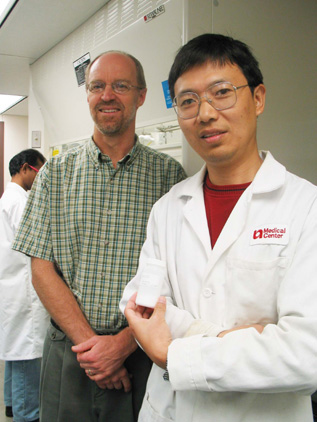 |
Yuxiang Dong, Ph.D., research associate, UNMC College of Pharmacy, far right, holds a bottle of the compound developed into what he and Jonathan Vennerstrom, Ph.D., associate professor of pharmaceutical sciences, UNMC College of Pharmacy, center, hope will be the next and best anti-malarial drug on the market. Working in the background is researcher Kamaraj Sriraghavan, Ph.D. |
If the drug works as hoped, it could be marketed to treat malaria at a cost much less than commonly used anti-malarial drugs.
The UNMC-led team, which has been funded by Medicines for Malaria Venture (MMV) of Geneva, Switzerland, since 2001, is made up of scientists from the UNMC College of Pharmacy, Monash University in Australia, the Swiss Tropical Institute and the F. Hoffmann-LaRoche pharmaceutical company in Switzerland. The group received a patent on the drug compound and shares a five-year, $5.5 million MMV grant.
Jonathan Vennerstrom, Ph.D., associate professor of pharmaceutical sciences at the UNMC College of Pharmacy, led the project, which is now transitioning to Ranbaxy Laboratories Ltd., one of India’s largest pharmaceutical companies.
“Dr. Vennerstrom has achieved a very significant milestone,” said Clarence Ueda, Ph.D., dean of the UNMC College of Pharmacy. “Although a number of other hurdles still remain, his years of dedication and effort appear to be panning out. I’m very, very pleased for him.
“He and his team are an excellent example of what being scientists is all about, especially one in academia – commitment, focus, perseverance, dedication, teamwork, and, of course, hard work. It’s not your everyday scientist that pursues a research career in an area such as malaria, especially in the United States, where the financial gains are not that enticing. Dr. Vennerstrom chose a career in science for the right reasons,” Dr. Ueda said.
Though the malaria epidemic seems like a world away, in places such as Africa, Asia, Central and South America, the disease kills more than 2 million people each year, most of them children and pregnant women, according to the World Health Organization (WHO). In addition, an estimated 300 million to 500 million new cases of malaria are diagnosed each year. More than 90 percent of all malaria cases occur in Africa. Also at risk are those who travel to countries where malaria is prevalent.
Dr. Vennerstrom and his team are humbled by their success, as they know there are many hurdles before a drug reaches the market. “This has been a wonderful project,” Dr. Vennerstrom said. “I’ve been blessed with such good people in our lab and our project partners. There’s always a chance that drug candidates can fail, but so far there have been no problems with it.”
The team continues to perfect the compound to make it better, he said. “We have a number of really good backup compounds should something happen to this one,” Dr. Vennerstrom said. “The current drug has made it to phase I. We’re all quite confident it will work well in patients. This drug has such powerful anti-malarial properties. The properties in animal models were so much better than any other anti-malarial drug out there.”
Yuxiang Dong, Ph.D., research associate in the UNMC College of Pharmacy, thought he’d have a “nice paper in a publication” when he discovered the compound.
“I didn’t realize the potential until the WHO (World Health Organization) said it was ‘spectacular,’ ” Dr. Dong said. “We didn’t think it was a big deal at the time. We’ve had tremendous success. To me, it’s a big satisfaction. Maybe this is the beginning.”
Called the Synthetic Peroxide Project, in 2001 it was the first new drug candidate to be entirely funded by MMV, and also was voted Project of the Year in 2001. MMV was officially launched in 1999 as a non-profit foundation dedicated to reducing the burden of malaria in disease endemic countries by discovering new affordable anti-malarials through effective public-private partnership.
MMV currently funds 21 projects. Dr. Vennerstrom’s project is considered one of four MMV accelerated projects. One of MMV’s major sources of funds is the Bill and Melinda Gates Foundation.